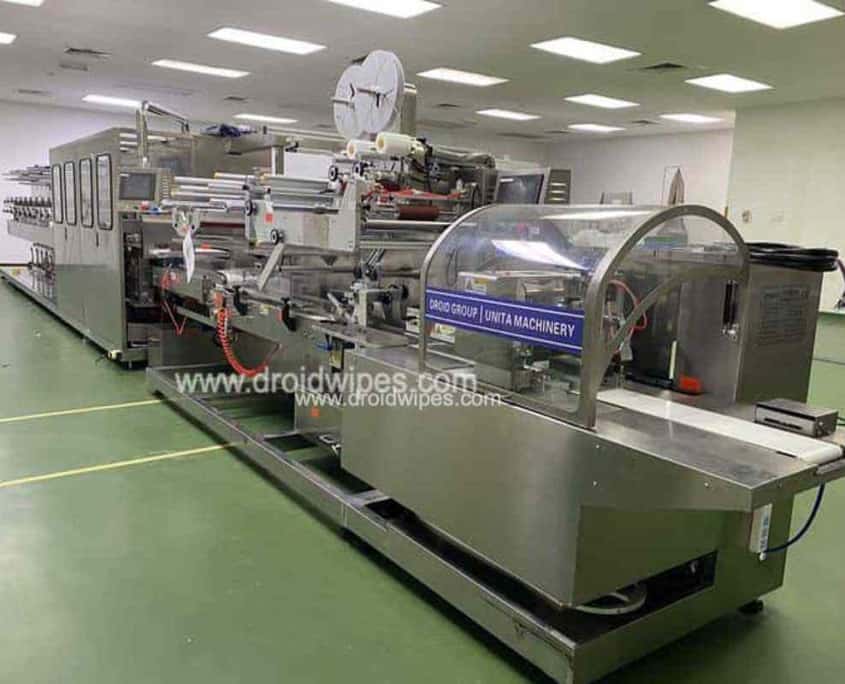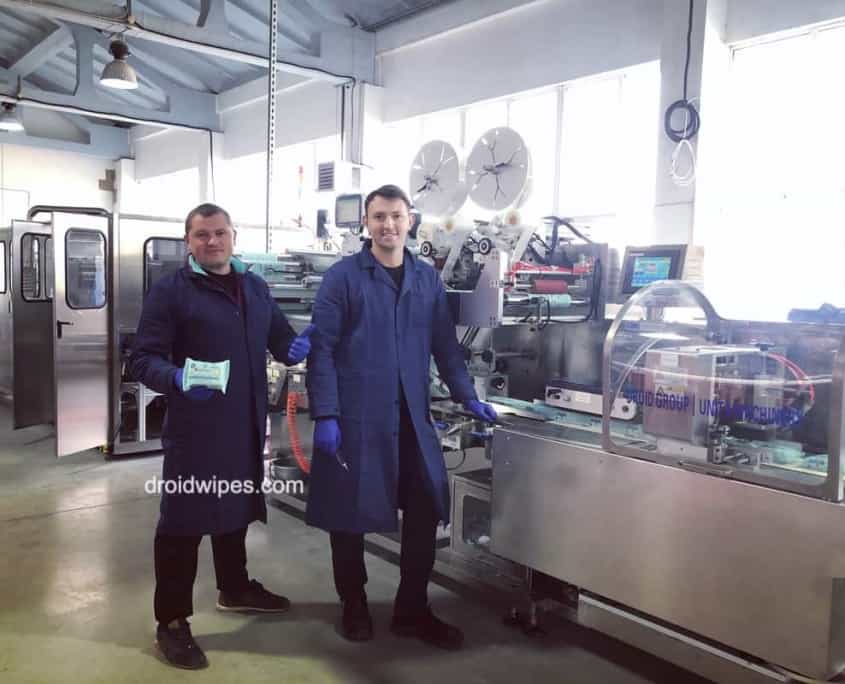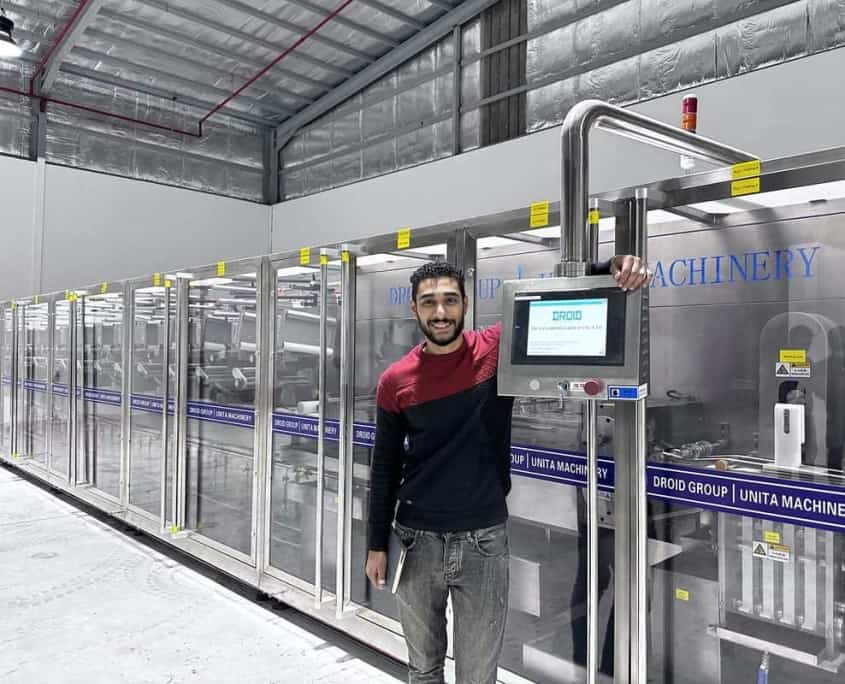Tip 1: Clean the Machine Regularly
The key to keeping your wet wipes machine operating at its best is regular cleaning. Tiny fibers, lotion residues, and dust from packing film are left behind after every manufacturing cycle. If these contaminants are not removed, they may clog nozzles, discolor packaging, or even lead to mechanical issues.
Using gentle, lint-free towels and authorized cleaning solutions, begin by cleaning all visible surfaces after each shift. The quality of the wipes and the integrity of the package are directly impacted by accumulation in essential locations such as cutting blades, folding plates, liquid dispensing nozzles, and heat-sealing jaws.
Plan weekly or biweekly shutdowns to allow for safe access to internal components for further cleaning. Clear fabric dust from moving parts, remove excess lotion from pipes and tanks, and inspect the sealing system for any residue that might compromise airtight packing.
Sensitive sensors, control panels, or electrical systems may be harmed by using strong chemicals or high-pressure water in the incorrect places. Always adhere to the manufacturer’s cleaning instructions.
Making cleaning a routine and habit can help you avoid contamination, minimize wear on essential parts, eliminate unplanned downtime, and keep your wet wipes manufacturing line operating and looking professional.
Tips 2: Inspect the Machine for Any Damage
Cutting, folding, pouring liquid, sealing, and packing at rapid rates are all part of a wet wipes machine’s hard labor. Because there are numerous moving components, minor faults can rapidly escalate into major ones if left unaddressed. Routine inspections are thus crucial.
Spend a few minutes visually inspecting the machine either before or after each manufacturing cycle. Inspect critical components, including conveyor belts, rollers, sealing jaws, and cutting blades, for any signs of cracks, dents, or loose parts. Examine belts and chains for wear, and listen for odd sounds—squeaks, grinding, or rattling are often indicators that something is amiss.
Check electrical cables for frayed or exposed wires, and be aware of leaks in hydraulic and pneumatic systems. Performance might be impacted, or safety risks can arise from even small leaks or electrical damage.
Create a straightforward checklist that operators can use to note any anomalies immediately. An incorrectly positioned bolt, a slightly misaligned blade, or a loose sensor may not halt production today, but identifying them early on helps avoid malfunctions and expensive downtime later on.
You can maintain consistent production quality, keep the machine operating safely, and prevent unforeseen repairs that may halt your wet wipes line just when you need it most by incorporating regular inspections into your daily routine.
Tips 3: Lubricate the Machine’s Parts
One of the easiest yet most effective methods to maintain the smooth operation of your wet wipes machine is to lubricate it regularly. Because there are numerous moving parts—such as gears, bearings, chains, and rollers—continuous friction can cause wear, overheating, and, ultimately, expensive malfunctions if not properly controlled.
Always use the prescribed oils or greases and adhere to the manufacturer’s lubrication schedule. Vibration is decreased, metal-on-metal contact is avoided, and component movement is facilitated by the proper lubrication. Take care not to lubricate too much, as excessive oil or grease may attract dust and fibers, causing buildup that impairs performance.
Make it a habit to routinely check the lubricating spots. While sticky residue may indicate over-application, dry or squeaky regions often indicate that lubrication is past time. Appropriate lubrication also ensures smoother operation and reduces unnecessary strain on the motor during high-speed operations, such as cutting or folding units.
Not only is a well-lubricated machine simpler to use and quieter, but it also has a lower chance of experiencing premature wear and tear. Your wet wipes machine will continue to function day after day if you keep parts flowing freely, since this will increase their longevity, reduce downtime, and ensure consistent production quality.
Tips 4: Replace Worn-Out Parts
Continuous usage causes natural wear and tear on even the greatest wet wipes machines. Cutting blades, belts, rollers, and seals are among the parts that operate under continuous pressure; when they wear out, they may cause manufacturing quality to suffer or operations to halt abruptly.
Develop the practice of routinely checking high-stress areas. Check for worn rollers, fractured belts, chipped or dull blades, or stiffened seals. A stretched belt may cause the entire line to lose its rhythm, and a blade that is not sharp enough will not cut cleanly.
Proactive replacement is significantly less expensive than emergency downtime, so don’t wait until a part goes entirely. Maintain a stock of essential replacement parts, particularly those with shorter lifespans, so you can replace them promptly and avoid halting production for days while waiting for delivery.
For information on part requirements and replacement periods, always refer to your machine’s maintenance handbook. If you use the incorrect part or put off a replacement, it may cause more serious and expensive damage down the road.
You can maintain optimal performance from your wet wipes machine, prevent unplanned malfunctions, and safeguard your investment over time by keeping up with regular maintenance and addressing wear and tear.
Tips 5: Check the Tension of the Belts
By powering rollers, conveyors, and folding units, belts are the unsung heroes of your wet wipes machine. However, belts may stretch, loosen, or wear down with time, which might impact the machine’s overall performance, alignment, and speed.
Establish a routine for regularly checking the belt tension. An excessively loose belt may slide, leading to misaligned folding, uneven cutting, or even production halts. Conversely, an excessively tight belt may put stress on motors and bearings, causing premature wear.
Check the tension according to the manufacturer’s instructions; most machines include reference points or adjustment mechanisms for simple calibration. When examining, look out for any cracks, fraying, or glazing on the belt’s surface, as these indicate that a replacement is necessary.
You can minimize mechanical stress, maintain constant output quality, and guarantee smooth, coordinated movement throughout the machine by maintaining your belts correctly tensioned and in excellent condition. You may save hours or even days of expensive downtime later by taking a few minutes to do belt inspections.
Tips 6: Keep the Machine in a Clean Environment
For optimal performance, your wet wipes machine requires a clean, regulated environment in addition to routine cleaning. Sensitive components are easily compromised by dust, dirt, and excessive moisture, which can result in jams, sensor errors, or packaging defects.
Place the machine in a dry, well-ventilated location as far away from pollutants as possible. Avoid placing it near open windows, busy places, and storage spaces where dust from cardboard, fabric fibers, or chemicals might be present.
Another unnoticed danger is moisture. Steer clear of places with high humidity or water sources nearby, as moisture and condensation can lead to corrosion, rust, and even electrical hazards. In addition to keeping belts and rollers in excellent shape and packaging materials stable, a regulated atmosphere also helps maintain the integrity of metal parts.
You can preserve the machine and the quality of your product by keeping your workplace dry and clean. This will ensure that every wipe meets safety and hygienic requirements, prolonging the life of your investment.
Tips 7: Follow the Manufacturer’s Instructions
No one understands a wet wipes machine’s construction better than the folks who created it. For this reason, it’s crucial to adhere strictly to the manufacturer’s maintenance guidelines. For your particular model, these instructions include detailed suggestions on the appropriate lubricants, cleaning solutions, replacement parts, and maintenance schedules.
It might be more detrimental than beneficial to disregard these guidelines or improvise with inappropriate items. While aggressive cleaning agents may corrode delicate surfaces or sensors, the incorrect lubricant can harm bearings. Similar to this, installing non-genuine parts may seem less expensive, but it often results in misalignment, decreased productivity, or even machine failures.
Provide your staff with easy access to the operation and maintenance handbook, and instruct operators to use it during standard inspections or when replacing parts. Additionally, many manufacturers provide service bulletins or updated instructions; follow them to make sure your machine is using the most recent best practices.
You can protect your machine’s performance, preserve product quality, and steer clear of avoidable problems that might reduce the lifetime of your equipment or need expensive repairs by following the manufacturer’s instructions.
How often should I clean my wet wipes machine?
To maintain important areas free of accumulation, light cleaning should be performed daily after each shift, followed by intensive cleaning once or twice a week.
What’s the best way to clean sensitive machine parts like sensors or control panels?
Avoid using strong chemicals or excessive water that could harm electronics; instead, use a soft, lint-free cloth and cleaning solutions recommended by the manufacturer.
How do I know when to replace cutting blades?
Examine for uneven cuts, chips, or dullness. It’s time to change the blades if the wipes are ripping or not cutting neatly.
What kind of lubricants should I use?
Use only the lubricants recommended by the manufacturer. Using the incorrect oil or grease might lead to excessive dust or harm to moving parts.
How often should belts be checked and adjusted?
Check belts for fraying, cracks, and proper tension once a week. To avoid slippage or strain on the machine, replace or adjust them as necessary.
Can I use third-party parts to save costs?
It is not advised. Non-genuine components may not fit correctly or be of substandard quality, which could cause more serious problems and void warranties.
How do I prevent rust or corrosion on the machine?
The machine should be kept in a dry, clean, and well-ventilated space. Steer clear of damp locations and clean exposed metal regularly.
What’s the most common maintenance mistake operators make?
Neglecting regular inspections and postponing basic fixes may cause minor problems to escalate and result in costly downtime.
Should I keep spare parts on hand?
Indeed. To minimize downtime when repairs are required, keep essential spares, such as belts, blades, and seals, on hand.
Why is it so important to follow the manufacturer’s instructions?
Failing to follow the manual’s precise instructions for parts, lubrication, and cleaning may result in expensive repairs, malfunctions, or product defects.





